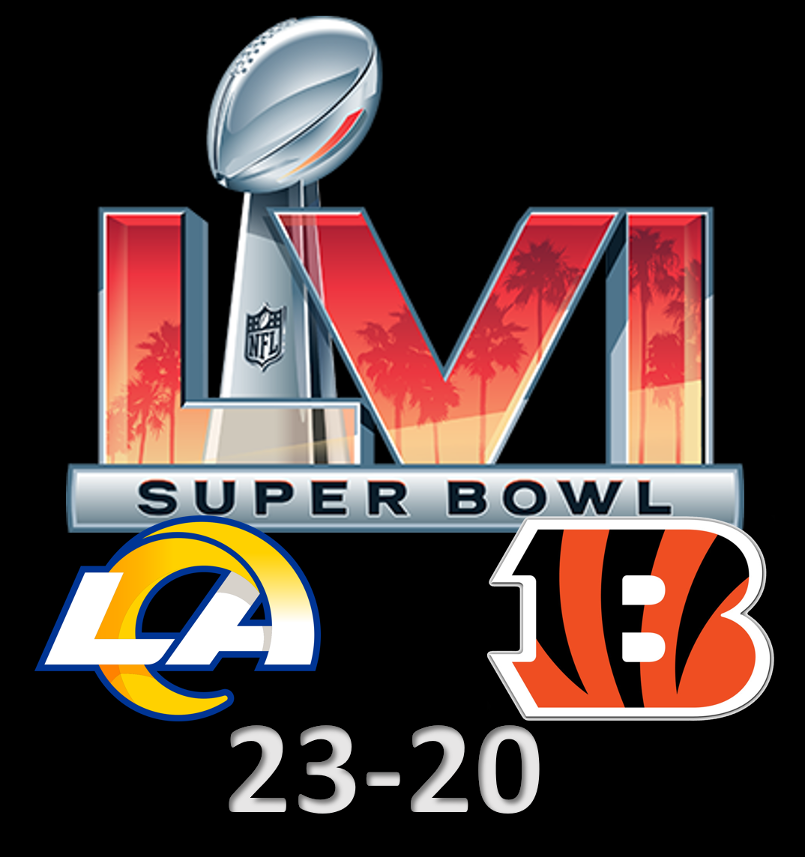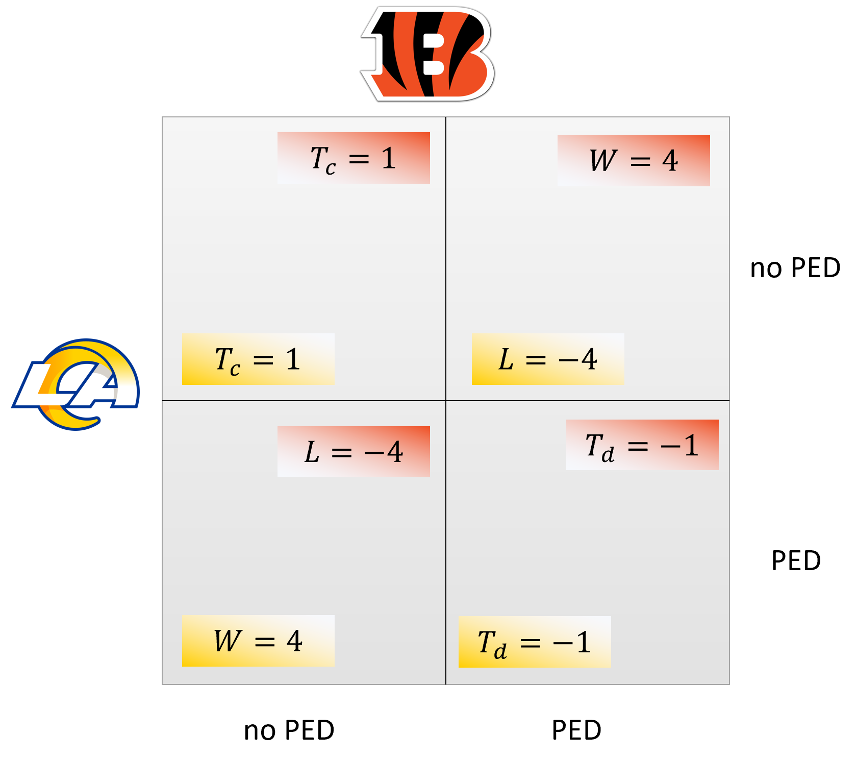Goldman's Super Bowl
There are lots of reasons to celebrate February. We have President’s Day commemorating the birthdays of our two most important holders of that office (Lincoln was born on the 12th and Washington on the 22nd). There’s Groundhog Day in which curious (and sometimes drunk) sit on the edge of their seats to see if that beloved rodent Punxsutawney Phil spots his own shadow thus heralding 6 more weeks of winter. And the romantic amongst us even go so far as to celebrate Valentine’s Day in which amorous desire takes corporeal form as a baby cherub decorating expensive tokens of affection bedecked in crimson and pink. But no other event is as anticipated, as hyped, or as watched as the Super Bowl.
This year’s game featured the NFC’s Los Angeles Rams, led by Matthew Stafford, against the AFC’s Cincinnati Bengals, led by Joe Burrow. The game was a true defensive struggle with the Rams coming out on top in the last few minutes of the game edging out the Bengals by a score of 23 to 20.
As one of the most watched sporting events in the world, the Super Bowl, with its promise of big money and enduring fame, certainly offers plenty of material for economic analysis. The usual spate of questions covers topics like how much a 30-second advertising spot sells for or whether public-funded stadiums offer a return on investment. But rather than focus on these areas, which get picked over every year, it seemed a lot more fun to consider the personal economics of the players. Just what were the sacrifices they were willing to make made (i.e., the opportunity costs they were willing to pay) and just how far were they willing to go to win at an elite level.
This is the very question that Robert M. Goldman started asking back in the early eighties. Goldman’s Dilemma, as the general form of the question is now known, has various ways of being stated but all them pose a ‘magical’ way for an athlete to excel in the immediate time frame while suffering horrible repercussions latter down the line. The original form of his question goes:
**If I had a magic drug that was so fantastic that if you took it once you would win every competition you would enter from the Olympic Decathlon to the Mr Universe, for the next five years but it had one minor drawback, it would kill you five years after you took it, would you still take the drug?" **
Goldman’s claim is that when he asked various athletes in the power-lifting and bodybuilding sports roughly half of them answered the question yes. Later research seems to either claim that the question as a whole is nonsense or to argue against the numbers being so large but it isn’t clear whether the differences are due to which sport is polled, or changing attitudes to winning, or just general issues with the sampling. What is clear is that there is ample evidence from most major sports that some athletes are willing to go to great lengths to win.
What is more interesting than the possible implications that Goldman’s Dilemma has with respect to doping in sports is that fact that game theory provides a successful framework to explain how even the possibility that one competitor is doping can incentivize others to break the rules even when they may not be inclined to do so on their own.
To see that let’s suppose that most athletes at the professional level are approximately equal to each other in drive, training, skill, and innate talent. The major distinguishing factors are then a set of intangibles headed up luck – luck when it comes to injury, team membership, or some other circumstance.
Case in point is Matthew Stafford the quarterback for the Rams, playing in his first Super Bowl. Prior to this appearance in the big game, Stafford was the starting quarterback for the Detroit Lions from 2009 to 2020. During these 11 years, he showed incredible resiliency and creativeness, often turning a busted play into a gain just by improvising using a combination of his athletic talent and his grit. Nonetheless, he only made 3 playoff appearances with the Detroit Lions, each one a loss. In 2021, he was traded to the Rams where his regular season performance was statistically on par with his 2011 season with the Lions (41 touchdowns in both years; 5,038 v. 4886 passing yards and a passer rating of 97.2 v. 102.9 for 2011 and 2021, respectively). This time, however, the result was a Super Bowl win in his first season with his new team.
Since the intangibles make a big difference in being on a perennial loser (i.e. the Detroit Lions) versus a winner (i.e. the Los Angeles Rams) its no wonder that some players are willing to dip into the shadowy side of sport training for a little boost. And for those doubters who think this too far-fetched consider the Tour de France.
Interestingly, game theory can give a model that matches this observed behavior even in one of the simplest games – the prisoner’s dilemma. To see this let’s consider two athletes, one from the Cincinnati Bengals and one from the Los Angeles Rams. Each is considering whether or not to take performance enhancing drugs (PEDs).
For the sake of this argument, we will assume that both players are evenly matched and only intangibles like luck or circumstances out of their control govern whether one will prevail of the other on any given Sunday. In this situation, we will assign each player a payoff value of 1 since neither is coming out a loser, on average, with respect to the other. Symbolically, we will denote this payoff as $T_c$, where the subscript ‘c’ reminds us both players are clean.
If one of these players decides to take PEDs, he perceives that he will win most of the time and this payoff we will denote as $W=4$. The other player, being soundly defeated, will have a converse payoff of $L=-4$.
Finally, if both players take PEDs, they will again be at a stalemate but they will have suffered damage to both their bodies (assuming PEDs are harmful) and to their reputations should they be discovered as ‘cheaters’. The payoff here will be $T_d = -1$ where the subscript ‘d’ reminds us that both players are ‘dirty’.
The full payoff matrix looks like:
Up to inconsequential things like the actual numerical values used and the names provided, this payoff matrix is functionally identical to the matrix for the prisoners dilemma. The fact that $ W > T_c > T_r > L$ guarantees that there is only one pure strategy – both players take the PEDs in order to not ‘lose’.
Does this analysis mean that every athlete succumbs to the pressure and that every sport is rife with cheating? The obvious answer is of course not. First of all, the real-world situation is much more complex as there are more than two players and more than two possible outcomes. Far more important than those observations is the fact that the above payoff matrix implies that each player sees the world in exactly the same fashion and arrives at the same payoff values (or at least values consistent with the inequality that ranks a win at any cost as the most desirable outcome). The assumption that the payoffs are known and agreed upon by all players is the single greatest weakness that game theory and its adherents have to contend with. Nonetheless, the economic psychology that would lead some subsets of athletes to cheat and what changes need to be made to minimize this possibility make game theory at least a good, if not exactly a super, starting point.


